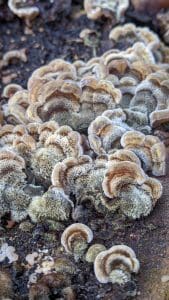Tripe Fungus / Autumn / Inedible
The Tripe Fungus (Auricularia mesenterica) is an unusual and eye-catching mushroom, often found on the decaying wood of broadleaf trees across the UK, Europe, North America, and parts of Asia.
Named for its resemblance to animal tripe, this fungi features a distinctive layered structure with a tough, gelatinous texture. The upper surface is often covered with fine, velvety hairs and displays a range of colours from grey to brown, while the underside has a wrinkled, vein-like appearance that can range from white to pale brown.
When I first came across this mushroom when running an event in Italy I initally thought ‘ah a turkey tail mushroom’ then I touched it, stepped back and thought ‘what’s going on here’ this is like the baby of a turkey tail and a jelly ear mushroom.
Unlike many other mushrooms, the Tripe Fungus is not commonly sought after for culinary purposes due to its rubbery texture and unremarkable taste.
However, it holds an important ecological role as a decomposer, breaking down dead wood and contributing to nutrient cycling within forest ecosystems.
In this article, we will explore the unique characteristics of the Tripe Fungus, including its appearance, habitat, and ecological significance, providing a comprehensive guide for those interested in identifying and understanding this fascinating species.
Scientific Name
Auricularia mesenterica
Common Name
Tripe fungus
Family
Auriculariaceae
Habitat and season
Saprophytic growing dead elm trees and branches,
Summer to early winter actively growing when damp.
Identifying Features of the Tripe Fungus
A very fascinating and peculiar looking fungi, exhibits multiple features you wouldn’t expect to see on the same fruiting body. With its bracket like shape but gelatinous flesh, zoned colouration and hairy upper side it’s like the platypus of the fungi kingdom
Can vary depending maturity
Upperside (infertile)
Bracket like in shape, loosely attached to the wood host, zoned concentric bands of beige shades, cream and khaki, covered in fury hairs. Wrinkled and undulating surface and margin.
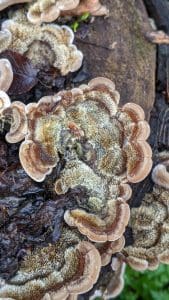
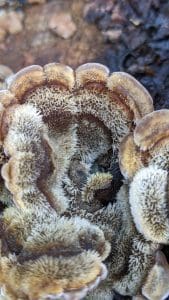
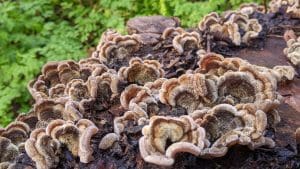
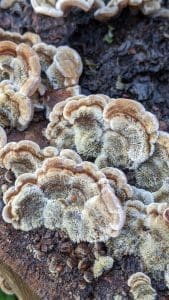
Underside ( fertile)
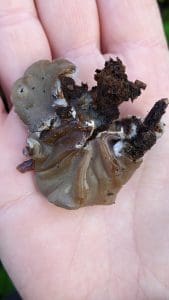
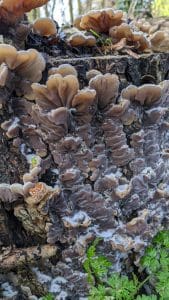
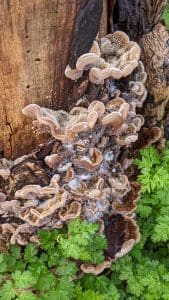
Gelatinous light brown in colour with a slight translucent appearance
Flesh like light brown jelly
Smell:
none
Spores
white
Uses of Tripe Fungus
Not poisonous but classed as inedible due to its tasteless tough, rubbery and hairy fruiting body
Cooking with Tripe Fungus
Tripe Fungus (Auricularia mesenterica) is closely related to the more well-known Wood Ear mushrooms (Auricularia auricula-judae), and while it may not be a common ingredient in Western kitchens, it can be used similarly in recipes. This fungus has a rubbery, gelatinous texture and is often used in soups and salads, particularly in Asian cuisine.
If you’re interested in cooking with Tripe Fungus, you can treat it much like Wood Ear mushrooms. After thoroughly cleaning and soaking to hydrate them, they can be added to dishes for their unique texture, which is often described as a bit crunchy and chewy, similar to “inside-out pasta.” Popular preparations include adding them to stir-fries, soups, and salads where they absorb the flavours of the dish.
For a recipe idea, you could try a salad with wood ear mushrooms and asparagus with a citrus miso dressing. This simple dish highlights the mushroom’s texture and its ability to complement fresh, crisp vegetables (First Nature) (Tyrant Farms).
While specific recipes for Tripe Fungus may not be widely available, general Wood Ear recipes can be adapted, as both mushrooms share similar culinary properties.
Conservation Considerations
Fairly common depending on abundance of dead Elm wood.
Tripe Fungus Could Be Confused With
Jelly ear fungus- Auricularia auricula-judae as edible species found predominantly on elder wood. In the same family as tripe fungus. The smooth jelly under side of the tripe fungus is very similar to jelly ear, but jelly ear lacks the hairy zones upper side.
Caution and known hazards
None known



